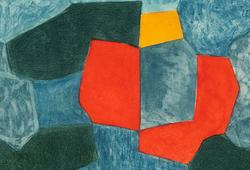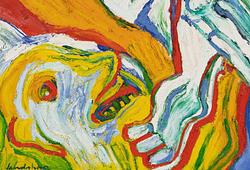Gustaf Fjaestad
Rime frost over frozen lake in sunlit landscape
Signed G. Fjaestad and dated 97. Oil on canvas 115 x 160.5 cm
Provenance
Private Collection, Latvia, (acquired from the exhibition mentioned below in 1928).
Private Collection, Ontario, Canada.
Private Collection, Sweden.
Exhibitions
Swedish Exhibition, Latvian National Museum of Art, Riga, Latvia, 1928, cat. no. 29.
More information
Gustaf Fjæstad was renowned for his depictions of frozen landscapes and is considered the foremost interpreter of the Swedish winter. As one of the leading Swedish painters at the turn of the last century, he was celebrated in his time for his virtuoso winter scenes depicting the snow-laden forests and the picturesque, frozen lakes of Värmland.
Fjæstad's attraction to landscape painting was closely tied to a profound interest in nature and outdoor life. Winter and cold did not deter him in any way from being outdoors. In his youth, he was a celebrated ice skater, and his fascination with snow, ice crystals, and hoarfrost persisted throughout his life and artistic career.
Fjæstad achieved his breakthrough with a series of snow motifs at the Artists' Association exhibition in Stockholm in 1898 and has since been associated with depictions of the Swedish snow landscape. He primarily drew his subjects from Värmland, where he became a central figure for a group of artists, including Björn Ahlgrensson, Fritz Lindström, and Bror Lindh, who gathered around his studio and person by Lake Racken outside Arvika, a collective that art history has named the Rackstad group. In addition to painting, Fjæstad had a great interest in applied arts. He designed ceramics, drew furniture, and periodically worked as a violin maker. In 1898, he married the artist Maja Hallén. The couple began a close collaboration in which Maja, alongside her own artistic practice, wove tapestries and other textiles based on her husband's designs. Famous examples of these can be found today in the Thiel Gallery in Stockholm and at the Rackstad Museum in Karlstad.
Gustaf Fjæstad's hymns to hoarfrost emerged around the turn of the century. A starting point was Hoarfrost on Ice (1900), which was purchased by Ernest Thiel and is now a highlight in the Thiel Gallery's collection. It was precisely paintings of this compositional type, almost a kind of formula, that Fjæstad would build his success upon and that he would repeatedly execute throughout his continued career. This pictorial idea almost always contained an open scene with a frozen lake flanked by snow-laden branches at the water's edge, where the ice reflects the colours of the sky or is adorned with small flowers of hoarfrost and the slight striped effect that can occur on the ice. The surface was emphasised with cohesive colour fields and a play of lines reminiscent of the Art Nouveau style.
All of these components can be found in the current painting Hoarfrost over Frozen Lake. The painting has an engaging composition that invites the viewer's eye to wander through the sparkling winter scene, where delicate forms highlight the branches that glisten in the cold from the various qualities of the frozen water. Here, Gustaf Fjæstad conveys the poetry of a quiet winter's day in a successful synthesis of realism, idealism, a sense of nature, existential depth, and contemplation in a particularly impressive painting.
Artist
Gustav Fjaestad was a pupil of Bruno Liljefors and Carl Larsson. He became renound for his depictions of Swedish winter landscapes, often with glistening icecrystals and bubbling water by ice's edge, sometimes lit up by the setting sun, sometimes in scales of grey, white and purple. He also designed templates for woven wallpapers, furniture, and wrought iron. He is represented in major Swedish museums as well as in Vienna and Chicago.
Read more


















































